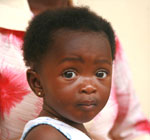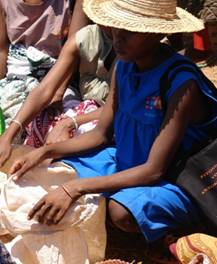For Flora Bertizzolo, 30, a health and nutrition program officer at the United Nations World Food Program (WFP), getting food to children in need in Madagascar is her first priority. She and her colleagues at the WFP office in Madagascar run a program that gets food assistance to more than 65,000 mothers and children in the most food-insecure areas of the country during the lean season.
But she believes the families she serves need more than food to prevent malnutrition. That is why the WFP team—located in the capital city of Antananarivo and in sub-offices around the country—collaborates with other organizations to make sure that food is part of an integrated effort to prevent malnutrition and improve health.
“Food is not the only solution to nutritional problems. We need to work with a range of partners who offer behavior change interventions, health systems strengthening, and capacity building in order to effectively reduce malnutrition,” she said.
But in a country where diverse aid organizations are working on a variety of nutrition and health activities, it has been difficult for implementers like Flora to identify potential partners working in different areas of the country. That’s where IYCN’s Gap Analysis of Nutrition Coverage in Madagascar came in. In 2008, IYCN conducted a survey of nutrition partners in Madagascar to understand the coverage of interventions, including essential nutrition actions and growth monitoring and promotion. The project used geographic information systems technology to map the results. In January 2009, IYCN published a report showing where different nutrition organizations were working, where interventions overlapped, and where there were gaps.
The results helped WFP and other organizations improve program planning, identify needs for nutrition interventions, and find new partners. After seeing the analysis, Flora and her team realized that their activities were not well linked to other existing nutrition programs. As a result, WFP has identified several new nutrition partners in the south of the country, where thousands of people are vulnerable to malnutrition as a result of a chronic drought. The analysis also helped the team plan more effectively so that their programs did not overlap with other interventions. In 2008, WFP started collaborating with the United Nations Population Fund on maternal and child health and nutrition activities in ten health centers in the drought-prone south.
“Since food is only a part of the effort to prevent malnutrition, IYCN’s analysis is helping WFP to identify health and nutrition partners in the most food-insecure areas,” said Flora.
After working in Madagascar for nearly two years, Flora sees the difference that food is making in the lives of mothers and children. She believes that combining food assistance with other interventions to prevent malnutrition and improve health will have a lasting impact.
View IYCN’s Gap Analysis of Nutrition Coverage in Madagascar.
Learn more about IYCN activities in Madagascar.
Date: Sep 6, 2009 | Category: Success stories

